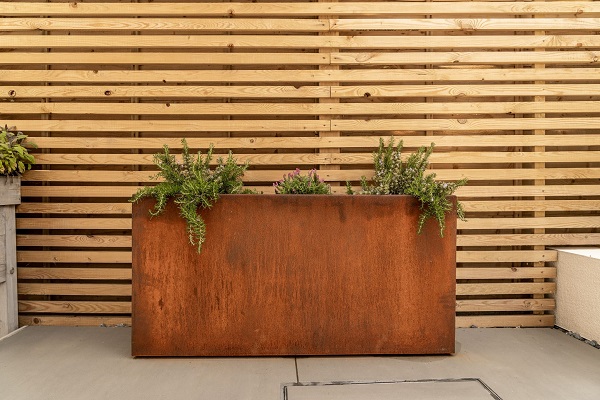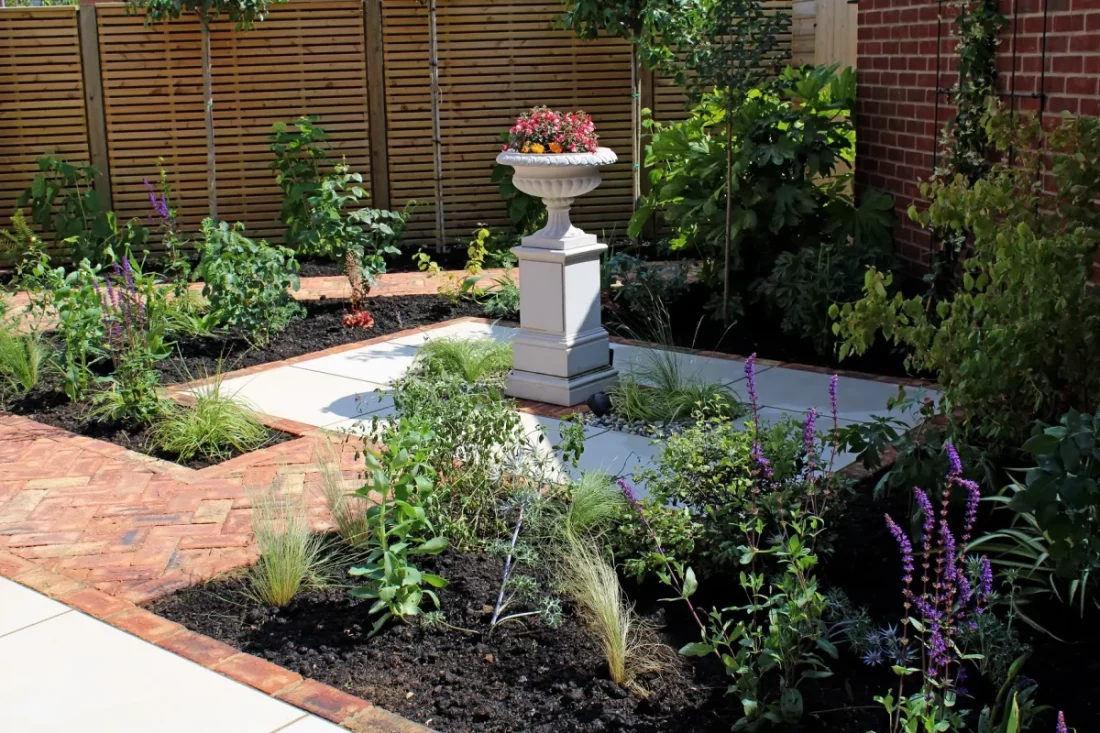Adding an edge detail completes any porcelain paving project, offering the flexibility to blend subtly or contrast strikingly with the main paved area. If you are wondering what porcelain edging slabs to choose for your patio, take a look at our porcelain patio edging ideas to give your garden the perfect finish.
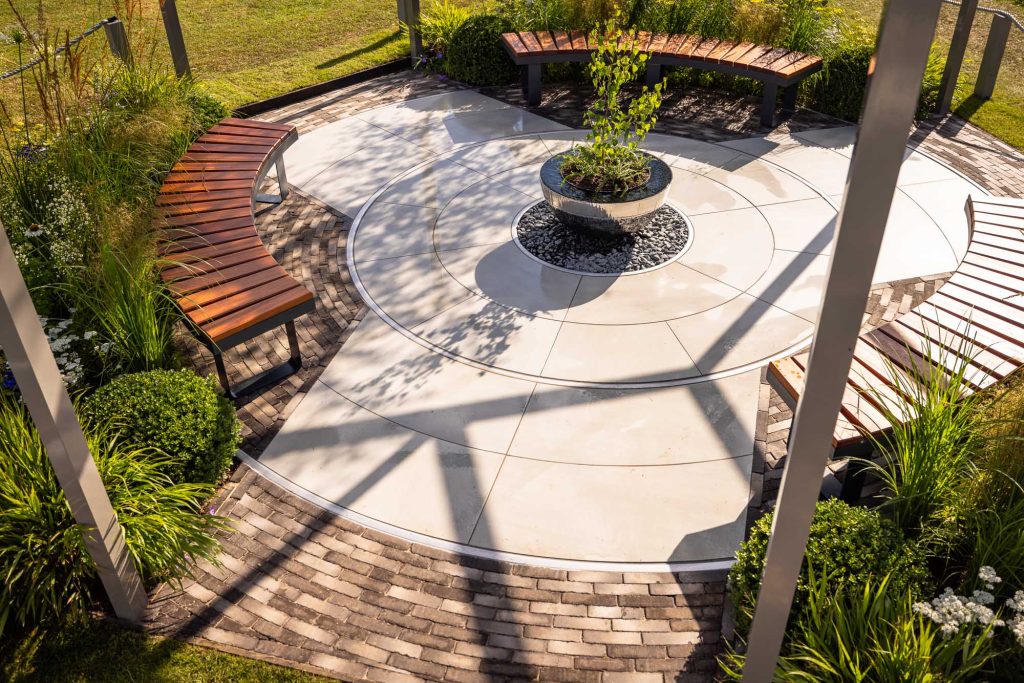
Porcelain patio edging: what is it and do you need it?
Every patio has an edge, but how you choose to finish that edge will depend on your budget, ground levels and space available, as well as your personal taste. Garden edging is a design detail to have fun with. Edging is a great opportunity to add a finishing touch to your garden space, allowing you to inject detail, textural contrast, colour and interest into a large expanse of porcelain paving.
However, don't feel that you have to have a specific edging for your porcelain paving slabs. It's perfectly acceptable to choose the shape of patio you want and then lay your choice of tiles to the edge of that shape. The most important thing is to construct a porcelain patio to the correct quality standard. Find out more about how to lay porcelain slabs the right way.
Let's look at the large range of porcelain patio edging ideas on offer that can give your outdoor space that special touch.
If you'd like more information after reading this, then please contact our helpful team to explore your options further.
Choosing the edges of your porcelain patio
A patio can be constructed in several different ways:
- Raised above its surroundings - it may be placed at a significant height, or could be no more than a shallow step up from ground level
- Flush with the surrounding ground - often a lawn abuts the patio and is on exactly the same level
- Edged with garden walling, fence or raised bed
We take you through porcelain patio edging ideas for all three possibilities.
How to finish the edges of a raised patio
Raised patios present a visible edge and vertical face. This means you have the opportunity to add character to both the sides and edge of the patio. The vertical sides of a raised patio can be faced with bricks, porcelain external cladding or composite battens. Or, you could choose to face your patio with porcelain to match the paving.
As well as the vertical surface, though, how would you like to finish the top edge?
Using step profiles for patio edge detail
Our porcelain step treads are available with a range of edge profiles. We've chosen them to complement different styles of garden design, whether you're looking for a more traditional feel or a modern minimalist look. These step treads are an ideal way to finish a raised patio, as you can see in the pictures below.
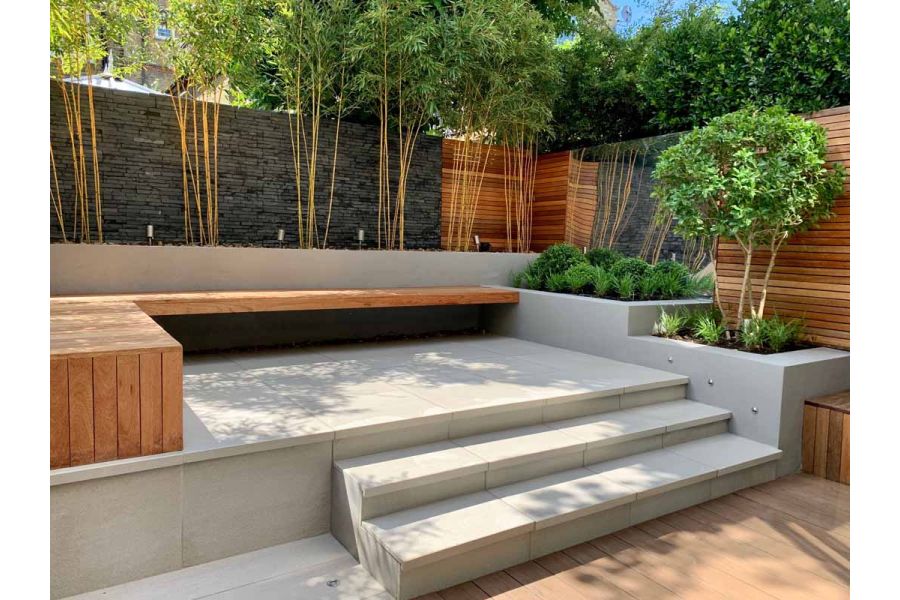
Here, designer Tom Howard chose a 40mm downstand edge profile as the ideal choice to complement straight lines and square edges - he's also faced the front of the patio with Urban Grey outdoor tiles to match the patio paving. A downstand creates a chunky straight edge that is perfectly in keeping with the simple outline of the raised beds, as well as helping to unite the design by providing an echo of the fencing battens.
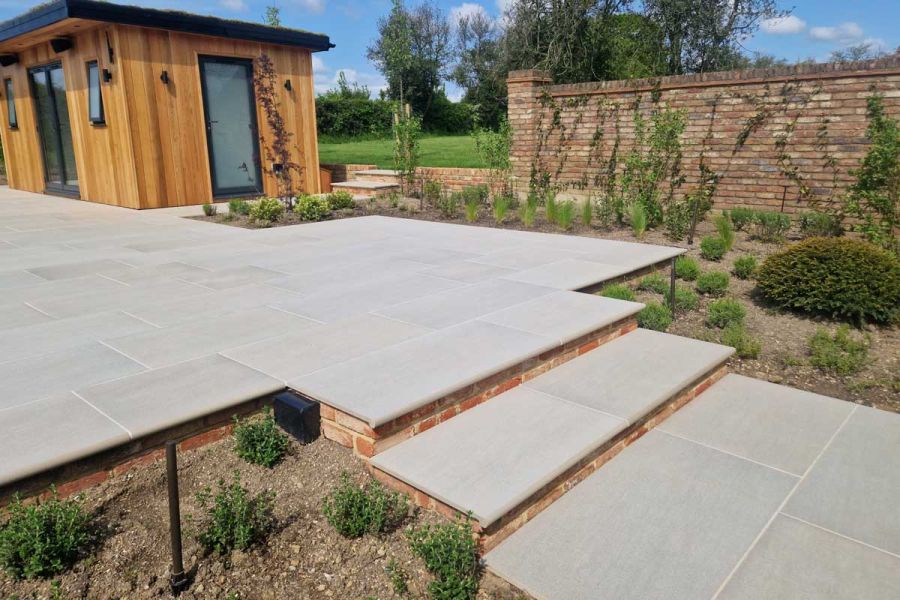
A bullnosed edge to your raised patio gives a more classic feel. This traditional, smooth, rounded profile looks at home with old brick walls and more cottagey planting. In the design above, Millscape have chosen our 40mm bullnose option to complement the brick risers to the steps and the brick face to the patio sides. You'll only find this 40mm bullnose edge at London Stone. We manufacture it in-house to create an alternative option to the 20mm bullnose which is the standard width. The extra depth adds weight to a design, increasing the porcelain paving's similarity to natural stone.
You'll only find this 36mm bullnose edge available at London Stone. We manufacture these bullnose units in-house to create an alternative option to the 20mm bullnose which is the standard thickness for exterior porcelain paving. The extra depth adds weight to the design, increasing porcelain paving's similarity to natural stone.
Other porcelain paving edge options include a simple chamfer, 20mm bullnose and 5mm pencil round profile.
A raised patio with a minimalist look
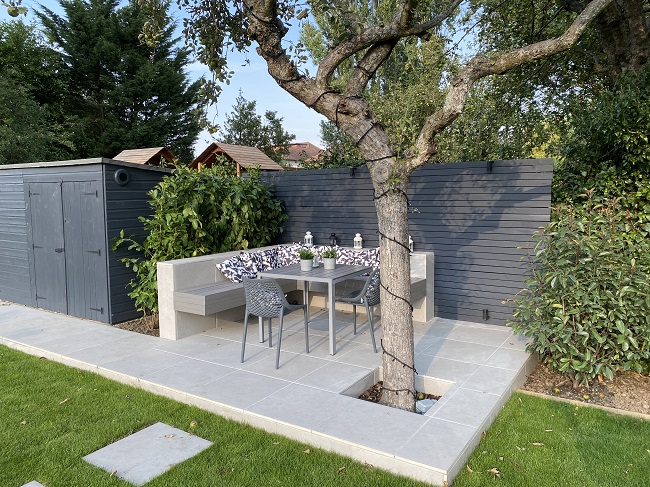
Of course, there's no need to finish a raised patio with a step tread profile. By cutting our Florence Grey pavers to size to create matching risers (the vertical part of the step up), Limebok Landscaping have shown how this neat edge looks fresh and modern - especially in combination with the stack bond paving pattern used for the patio and the narrow-slatted fence.
Ideas for edging a ground-level patio
With a ground-level patio, the edging is purely decorative, and there are many different ideas to play with. One of the easiest ways to add detail is by contrasting materials and colours - from adding pebbles to your design, to careful placement of flower beds and ponds.
Plank paving for patio edging slabs
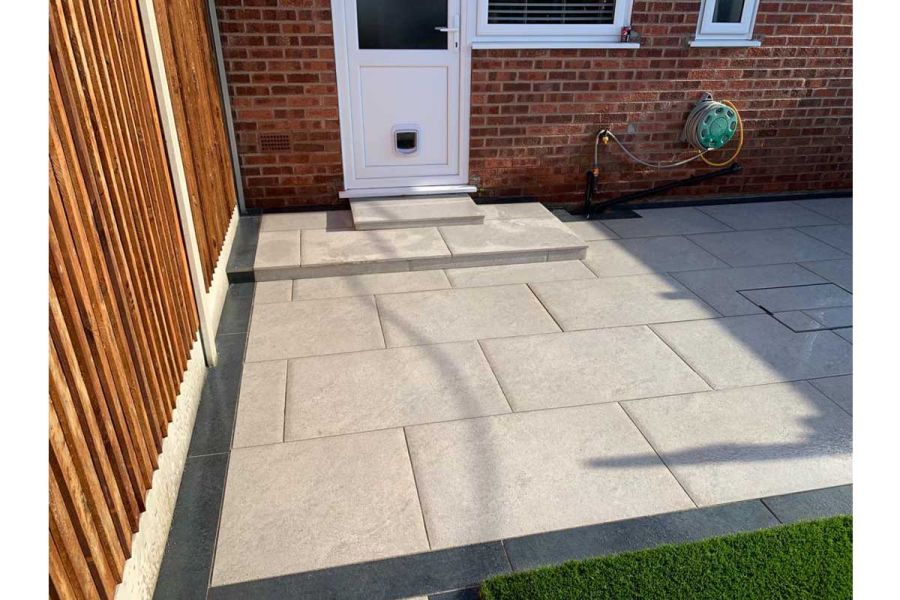
Linear paving, like the Charcoal planks in the picture above, makes ideal edging for porcelain paving slabs. Its narrow length provides an interesting contrast with larger patio slabs, creating a frame for the paving. You can choose to create a subtle textural difference by using matching porcelain paving slabs and planks or, as above, create a strong colour contrast to emphasise a patio's shape.
You'll find more planks in porcelain in our Project paving range.
Disguising a channel drain with dark patio edging
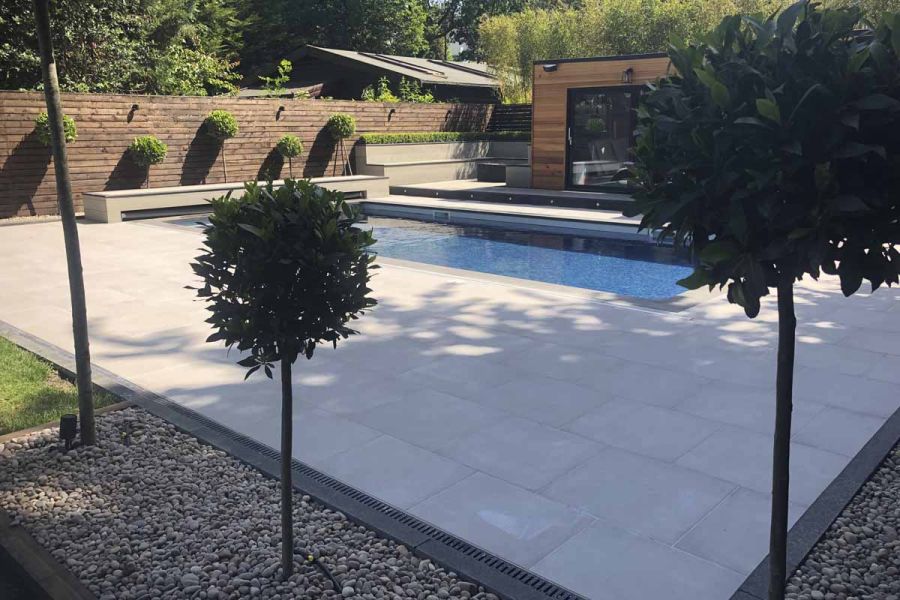
Choosing a contrasting colour can be useful for other reasons. The swimming pool terrace above has a dark edge that allowed the designer to disguise the channel drain, a utilitarian necessity that might otherwise have spoiled the lines of the patio.
Stone pavers for porcelain slab edging
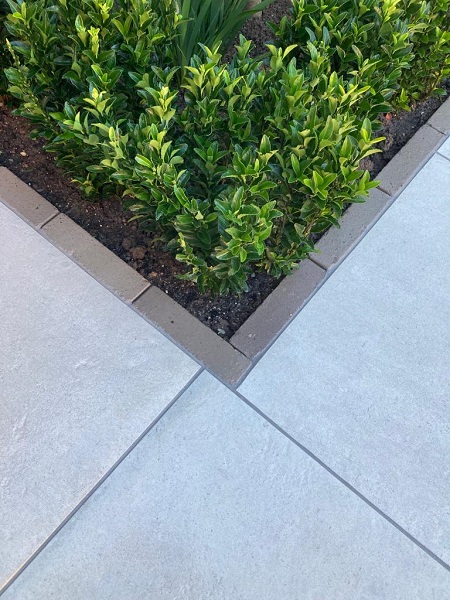
Instead of longer edging slabs, consider going shorter! A single line of stone pavers or paving bricks contrasts with the patio paving by using a smaller shape. Take a look at our natural stone pavers to create an effect similar to the one shown above. Choosing a natural stone such as Egyptian Beige limestone will add an interesting textural contrast to smooth porcelain.
Clay pavers for porcelain patio edging
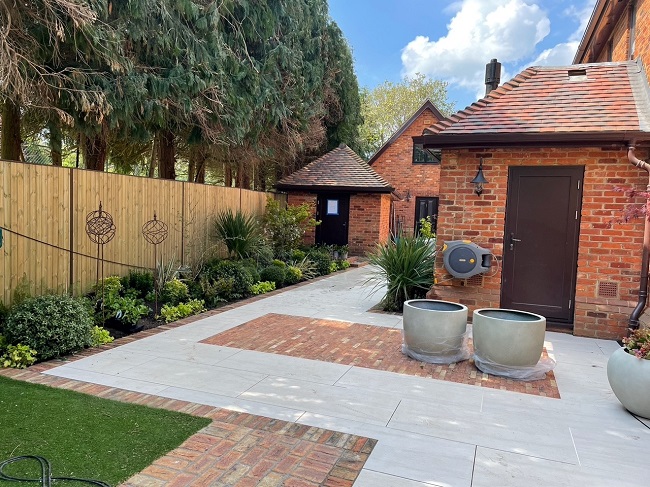
Clay pavers - such a traditional material - might surprise you. Clay and porcelain make a great design combo. Choose from a huge array of contrasting colours and textures to create a range of dark/light or rough/smooth contrasts. Clay pavers can be laid in a single row, or as a multitude of courses to make a bold edge to your patio, as shown in Lynn Cordall's design at the top of the page.
In the picture above, designer Olivia Lister has chosen to lay a soldier course, where the clay bricks are perpendicular to the paving, to create directional contrast and a wider frame.
Create a bold outline
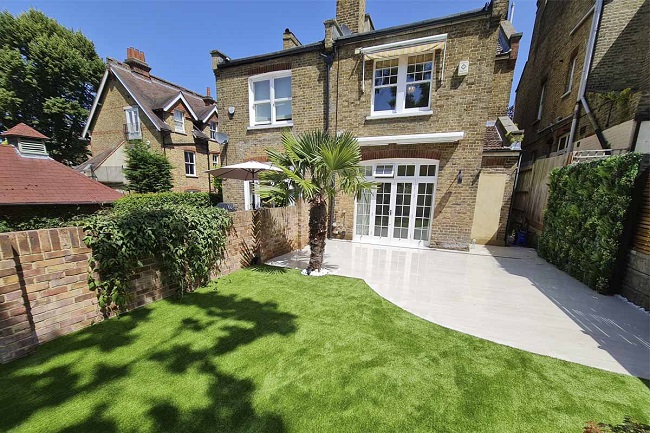
Sometimes simplicity is all you need. The porcelain patio pictured above is all about shape - no steps, no edging slabs. Just a clean sweep that stands out against the grass.
If you're tempted by this approach, expert cutting skills are a must. We’re happy to shape your purchase with our Bespoke Cutting Service to any design you choose. Alternatively, choose an experienced tradesperson from a range of local landscapers and have your paving cut on-site.
Adding verticals to patio edges
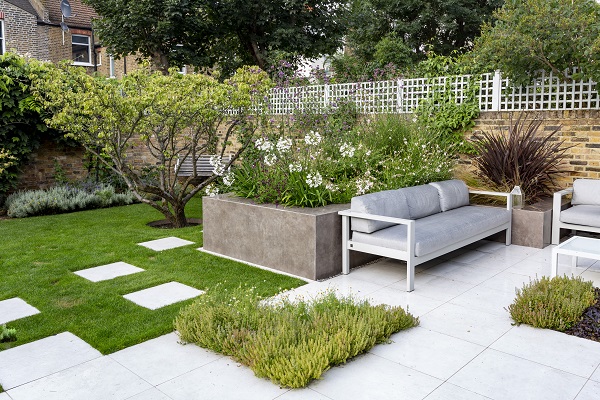
Raised beds give a completely different feel to a patio. Built deep, and well-planted, they increase the sense of privacy by screening you from your neighbours. Placed on the north side of a south-facing patio, they help to create a sun trap. Plant the beds with scented shrubs and plants (such as honeysuckle or night-scented stocks) and their perfume will surround you as you sit.
A raised bed patio edge also allows the injection of more colour and texture into your garden. In the picture above, external porcelain cladding complements the modern lines of the patio and furniture and adds mellow warmth to the light grey paving and upholstery.
Porcelain cladding is also a good edging for sunken garden patios.
Edging stones for porcelain patios
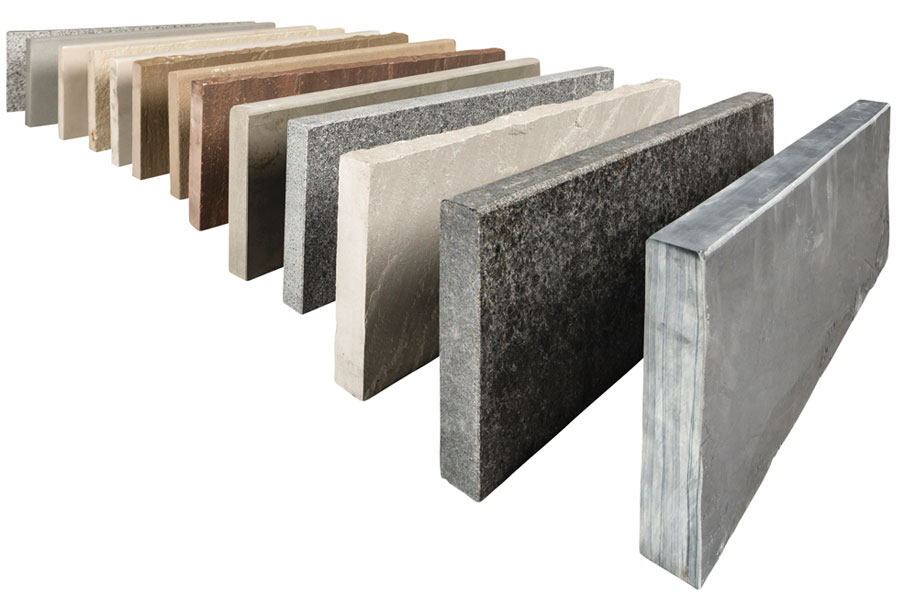
A planted border adds a lush, colourful edge to your porcelain paving. If you don't want to go the whole hog with a deep raised bed, then edging stones offer a neat solution that will prevent birds and the weather from spreading soil across your paving.
In granite, sawn or riven sandstone, these edging stones provide a raised edge that holds soil back and raises foliage from the ground, helping to keep your porcelain paving slabs clean.
Switching it around: a porcelain slabs edging idea
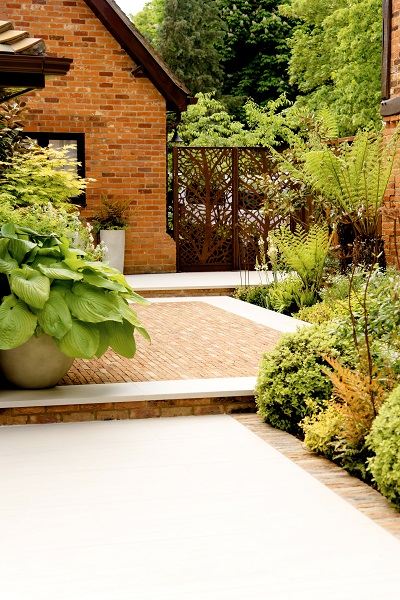
And finally, don't forget porcelain slabs make for a great patio edging idea themselves. You can create contrast with clay pavers or composite decking by framing the edge with light-coloured porcelain slabs.
For more inspiration, view porcelain patio ideas from leading designers.
Porcelain patio edging ideas offer plenty of ways to add your own personal touch to your outdoor space. If you'd like more information, please contact our helpful team to explore your options further.


/filters:quality(40)/mediadev/media/homepage/price_right_arrow.svg)
/filters:quality(60)/mediadev/media/menu-pics/menu_banner_mobile.png )
/filters:quality(60)/mediadev/media/menu-pics/all-porcelain.jpg )
/filters:quality(60)/mediadev/media/menu-pics/luxury-italian.jpg )
/filters:quality(60)/mediadev/media/menu-pics/premium-italian.jpg )
/filters:quality(60)/mediadev/media/menu-pics/budget-porcelain.jpg )
/filters:quality(60)/mediadev/media/menu-pics/large-format-porcelain.jpg )
/filters:quality(60)/mediadev/media/menu-pics/wood-effect-porcelain.jpg )
/filters:quality(60)/mediadev/media/menu-pics/porcelain-planks.jpg )
/filters:quality(60)/mediadev/media/menu-pics/porcelain-setts.jpg )
/filters:quality(60)/mediadev/media/menu-pics/browse-all-paving.jpg )
/filters:quality(60)/mediadev/media/menu-pics/stone-paving.jpg )
/filters:quality(60)/mediadev/media/menu-pics/interior-tiles.jpg )
/filters:quality(60)/mediadev/media/menu-pics/stone-effect-porcelain.png )
/filters:quality(60)/mediadev/media/menu-pics/wood-effect-porcelain.png )
/filters:quality(60)/mediadev/media/menu-pics/grey-porcelain.png )
/filters:quality(60)/mediadev/media/menu-pics/beige-porcelain.png )
/filters:quality(60)/mediadev/media/menu-pics/dark-porcelain.png )
/filters:quality(60)/mediadev/media/menu-pics/light-porcelain.png )
/filters:quality(60)/mediadev/media/menu-pics/patio-grout.jpg)
/filters:quality(60)/mediadev/media/menu-pics/primers.jpg)
/filters:quality(60)/mediadev/media/menu-pics/porcelain-blades.jpg)
/filters:quality(90)/mediadev/media/menu-pics/drainage.jpg)
/filters:quality(60)/mediadev/media/menu-pics/cleaners.jpg)
/filters:quality(60)/mediadev/media/menu-pics/all-stone-paving.jpg )
/filters:quality(60)/mediadev/media/menu-pics/all-sawn-paving.jpg )
/filters:quality(60)/mediadev/media/menu-pics/all-riven-paving.jpg )
/filters:quality(60)/mediadev/media/menu-pics/indian-sandstone.jpg )
/filters:quality(60)/mediadev/media/menu-pics/limestone-paving.jpg )
/filters:quality(60)/mediadev/media/menu-pics/granite-paving.jpg )
/filters:quality(60)/mediadev/media/menu-pics/slate-paving.jpg )
/filters:quality(60)/mediadev/media/menu-pics/yorkstone-paving.jpg )
/filters:quality(60)/mediadev/media/menu-pics/stone-pavers.jpg )
/filters:quality(60)/mediadev/media/menu-pics/cobbles-setts.jpg )
/filters:quality(60)/mediadev/media/menu-pics/plank-paving.jpg )
/filters:quality(60)/mediadev/media/menu-pics/paving-circles.jpg )
/filters:quality(60)/mediadev/media/menu-pics/bespoke-paving-1.jpg )
/filters:quality(60)/mediadev/media/menu-pics/edging-stones-1.jpg )
/filters:quality(60)/mediadev/media/menu-pics/prestige-stone.jpg )
/filters:quality(60)/mediadev/media/menu-pics/grey-blue-stone.png)
/filters:quality(60)/mediadev/media/menu-pics/swatch-black-dark.jpg )
/filters:quality(60)/mediadev/media/menu-pics/swatch-buff-beige-white.jpg )
/filters:quality(60)/mediadev/media/menu-pics/sealants.jpg)
/filters:quality(60)/mediadev/media/menu-pics/all-clay-paving.jpg )
/filters:quality(60)/mediadev/media/menu-pics/alpha-clay-pavers.jpg )
/filters:quality(60)/mediadev/media/menu-pics/cottage-garden-clay-pavers.jpg )
/filters:quality(60)/mediadev/media/menu-pics/kessel-garden-clay-pavers.jpg )
/filters:quality(60)/mediadev/media/menu-pics/artisan-clay-pavers.jpg )
/filters:quality(60)/mediadev/media/menu-pics/grey-blue-clay-paver.png )
/filters:quality(60)/mediadev/media/menu-pics/red-brown-clay-pavers.png )
/filters:quality(60)/mediadev/media/menu-pics/beige-buff-clay-pavers.png )
/filters:quality(60)/mediadev/media/menu-pics/composite-decking.jpg )
/filters:quality(60)/mediadev/media/menu-pics/designboard-decking.jpg )
/filters:quality(60)/mediadev/media/menu-pics/classic-designboard.jpg )
/filters:quality(60)/mediadev/media/menu-pics/brushed-designboard.jpg )
/filters:quality(60)/mediadev/media/menu-pics/grooved-designboard.jpg )
/filters:quality(60)/mediadev/media/menu-pics/millboard-decking.jpg )
/filters:quality(60)/mediadev/media/menu-pics/grey-decking.jpg )
/filters:quality(60)/mediadev/media/menu-pics/black-charcoal-decking.jpg)
/filters:quality(60)/mediadev/media/menu-pics/brown-decking.jpg)
/filters:quality(60)/mediadev/media/menu-pics/all-build-deck.png )
/filters:quality(60)/mediadev/media/menu-pics/stone-cladding.jpg )
/filters:quality(60)/mediadev/media/menu-pics/all-garden-walling-1.jpg )
/filters:quality(60)/mediadev/media/menu-pics/facing-bricks.jpg )
/filters:quality(60)/mediadev/media/menu-pics/garden-screening.jpg )
/filters:quality(60)/mediadev/media/menu-pics/menu_Garden_banner_desk.png )
/filters:quality(60)/mediadev/media/menu-pics/all-steps-coping.jpg )
/filters:quality(60)/mediadev/media/menu-pics/stone-garden-steps.jpg )
/filters:quality(60)/mediadev/media/menu-pics/sawn-steps.jpg )
/filters:quality(60)/mediadev/media/menu-pics/riven-steps.jpg )
/filters:quality(60)/mediadev/media/menu-pics/yorkstone-steps.jpg )
/filters:quality(60)/mediadev/media/menu-pics/bespoke-steps.jpg )
/filters:quality(60)/mediadev/media/menu-pics/porcelain-steps.jpg )
/filters:quality(60)/mediadev/media/menu-pics/off-the-shelf.jpg )
/filters:quality(60)/mediadev/media/menu-pics/stone-coping.jpg )
/filters:quality(60)/mediadev/media/menu-pics/sawn-coping.jpg )
/filters:quality(60)/mediadev/media/menu-pics/riven-coping.jpg )
/filters:quality(60)/mediadev/media/menu-pics/yorkstone-coping.jpg )
/filters:quality(60)/mediadev/media/menu-pics/bespoke-coping.jpg )
/filters:quality(60)/mediadev/media/menu-pics/stone-pier-caps.jpg )
/filters:quality(60)/mediadev/media/menu-pics/porcelain-coping.jpg )
/filters:quality(60)/mediadev/media/menu-pics/all-bespoke-services.jpg )
/filters:quality(60)/mediadev/media/menu-pics/bespoke-paving-2.jpg )
/filters:quality(60)/mediadev/media/menu-pics/bespoke-steps-1.jpg )
/filters:quality(60)/mediadev/media/menu-pics/bespoke-coping-1.jpg )
/filters:quality(60)/mediadev/media/menu-pics/edge-profiles.jpg )
/filters:quality(60)/mediadev/media/menu-pics/masonry-services.jpg )
/filters:quality(60)/mediadev/media/menu-pics/deluxe-pergolas.jpg )
/filters:quality(60)/mediadev/media/menu-pics/proteus-pergolas.jpg )
/filters:quality(60)/mediadev/media/menu-pics/corten_planter_menu.png )
 Trade Discount Available
Trade Discount Available FREE Nationwide Delivery
FREE Nationwide Delivery Nationwide Showrooms
Nationwide Showrooms Live Stock Levels
Live Stock Levels Split Packs Available
Split Packs Available